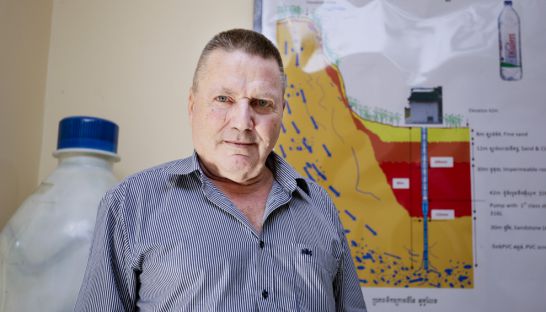Quenching a thirsty market
Quenching a thirsty market
With the mercury soaring, Cambodians are consuming more bottled water. Consumers can choose from dozens of local and imported brands, but Eau Kulen claims to be the only “natural mineral water” produced in the Kingdom. The Post’s Ayanna Runcie spoke to Jacques Marcille, managing director of Kulara Water Company, about how its brand stands out from the crowd in a saturated market.

How did your company come about?
We call it natural mineral water because it’s the only natural mineral water in Cambodia. We realised first that there was no mineral water [companies] in Cambodia. A long time ago we were in Vietnam, where we developed the mineral water, La Vie, which means ‘alive’ in French. This company has now been sold to Nestle.
Later, we were thinking that in a country like Cambodia you must be able to find natural mineral water, so I looked to find a good spring and we found one of the best sources of mineral water in all of Southeast Asia. This water naturally contains calcium and magnesium, which is very useful – especially in the Cambodian diet, because they lack magnesium.
We didn’t want any risk of contamination or pollutants from agricultural activity. Other water brands add chemicals during production for flavour or pesticides infiltrate their water source. But in our case, we are located one hour from Siem Reap at the foot of Kulen Mountain, which is in a forest preserve with no substantial agricultural production. The water percolates through the sandstone at the foot of the mountain, which filters it and enriches it with calcium and magnesium, and the result is fantastic natural water with good mineralisation.
Why is there a market for natural mineral water in Cambodia?
In many areas the water, which is pumped from traditional wells, has an excess of arsenic in it, and everybody knows that arsenic is not good for health. Some aquifers near Phnom Penh contain high levels of arsenic, though the city’s tap water contains no arsenic. The tap water is good and drinkable, but I prefer natural mineral water because the city’s water has barely any minerals in it.
How do you compete with the many other local brands here?
Our market is mineral water and their market is pure drinking water.
Besides the natural source, what is the difference?
You can build a small reverse osmosis plant in your house, which is relatively easy to do. In our case, we invested over $10 million in this [Eau Kulen] project, so if we don’t do things a better way at this price, we lose a lot of money.
Many small plants produce water, but when you see the bottle itself, sometimes it’s recycled PET, which means that after a certain time the PET might add a bad flavour to the water. You have some brands of water treated by reverse osmosis, which is totally safe, but it’s usually not mineral water. We are the only brand that bottles natural mineral water.
Do you export to other countries in Southeast Asia?
Not yet, but I think it will happen soon. We are in discussions, but to sell overseas is in some ways complicated as it means competing with brands that are already well known, like Evian and Vital. And for them, when you import a bottle from France to Singapore or from France to here, the cost of transportation is not that different with the cost of transportation between Sihanoukville and Singapore. It’s nearly the same because you have those big boats carrying up to 15,000 containers and you can imagine that the cost per container is relatively cheaper.
Have you considered selling your water in gallon or 5-gallon bottles like other local brands?
No, we are not going to sell water per gallon. The reason is very simple: people who use gallons in their kitchen change it regularly, but never clean the dispenser. So when you analyse the water that they drink or use, it has chloroform and bacteria. The dispensers are nearly never cleaned, so very often the good water is put into a dirty container and the result is contamination.
But the main reason why we don’t do the 5-gallon bottles is because you need to take back the containers and clean them before reusing them to sell water again. And you need to clean with water and detergent that will go into the river, the soil, and the aquifer, so you pollute the country.













